Effects of Gas and Steam Humidity on Particulate Matter Measurements Obtained Using Light-Scattering Sensors
Abstract
1. Introduction
2. Materials and Methods
2.1. RH Test
2.2. Steam RH Test
2.3. Analysis of Test Results
3. Results and Discussion
3.1. RH Test Data
3.2. Steam RH Test Data
3.3. Analysis of Test Results
4. Discussion
5. Conclusions
Author Contributions
Funding
Institutional Review Board Statement
Informed Consent Statement
Data Availability Statement
Conflicts of Interest
References
- Chen, A.; Wang, S.; Liu, Y.; Yan, S.; Zeng, J.; Deng, T. Light scattering intensity field imaging sensor for in situ aerosol analysis. ACS Sens. 2020, 5, 2061–2066. [Google Scholar] [CrossRef]
- Du, Y.; Ren, H.; Cai, W.; Qin, B.; Ma, X.-R. Effect of construction dust on urban PM2.5 emission characteristics: A case study of the main urban area of Chongqing, China. Nature Environ. Pollut. Technol. 2016, 15, 833–840. [Google Scholar]
- Kim, H.; Tae, S.; Zheng, P.; Kang, G.; Lee, H. Development of IoT-based particulate matter monitoring system for construction sites. Int. J. Environ. Res. Public Health 2021, 18, 11510. [Google Scholar] [CrossRef] [PubMed]
- Occhipinti, L.G.; Oluwasanya, P.W. Particulate matter monitoring: Past, present and future. Int. J. Earth and Environ. Sci. 2017, 2, 144–148. [Google Scholar] [CrossRef] [PubMed]
- Chow, J.C. Measurement Methods to Determine Compliance with Ambient Air-Quality Standards for Suspended Particles. Air Waste Manag. Assoc. 1995, 45, 320–382. [Google Scholar] [CrossRef]
- Jaklevic, J.M.; Gatti, R.C.; Goulding, F.S.; Loo, B.W. A beta-gage method applied to aerosol samples. Environ. Sci. Technol. 1981, 15, 680–686. [Google Scholar] [CrossRef]
- Guo, Q.; Zhu, Z.; Cheng, Z.; Xu, S.; Wang, X.; Duan, Y. Correction of Light Scattering-Based Total Suspended Particulate Measurements through Machine Learning. Atmosphere 2020, 11, 139. [Google Scholar] [CrossRef]
- Kim, K.-H.; Kabir, E.; Kabir, S. A review on the human health impact of airborne particulate matter. Environ. Int. 2015, 74, 136–143. [Google Scholar] [CrossRef]
- Covert, D.S.; Charlson, R.J.; Ahlquist, N.C. A study of the relationship of chemical composition and humidity to light scattering by aerosols. J. Appl. Meteorol. 1972, 11, 968–976. [Google Scholar] [CrossRef]
- Gebhart, J. Optical direct-reading techniques: Light intensity systems. In Aerosol Measurement: Principles, Techniques, and Applications, 2nd ed.; Baron, P., Willeke, K., Eds.; John Wiley & Sons: New York, NY, USA, 2001; pp. 419–454. [Google Scholar]
- Wang, X.L.; Chancellor, G.; Evenstad, J.; Farnsworth, J.E.; Hase, A.; Olson, G.M.; Sreenath, A.; Agarwal, J.K. A Novel Optical Instrument for Estimating Size Segregated Aerosol Mass Concentration in Real Time. Aerosol Sci. Technol. 2009, 43, 939–950. [Google Scholar] [CrossRef]
- Castello, P.; Muscas, C.; Pegoraro, P.A.; Sulis, S. Improved fine particles monitoring in smart cities by means of advanced data concentrator. IEEE Trans. Instrument. Measure. 2020, 70, 5500409. [Google Scholar] [CrossRef]
- Bulot, F.M.; Johnston, S.J.; Basford, P.J.; Easton, N.H.; Apetroaie-Cristea, M.; Foster, G.L.; Morris, A.K.; Cox, S.J.; Loxham, M. Long-term field comparison of multiple low-cost particulate matter sensors in an outdoor urban environment. Sci. Rep. 2019, 9, 7497. [Google Scholar] [CrossRef]
- Crilley, L.R.; Shaw, M.; Pound, R.; Kramer, L.J.; Price, R.; Young, S.; Lewis, A.C.; Pope, F.D. Evaluation of a low-cost optical particle counter (Alphasense OPC-N2) for ambient air monitoring. Atmos. Measure. Techn. 2018, 11, 709–720. [Google Scholar] [CrossRef]
- Day, D.E.; Malm, W.C.; Kreidenweis, S.M. Aerosol light scattering measurements as a function of relative humidity. J. Air Waste Manage. Assoc. 2000, 50, 710–716. [Google Scholar] [CrossRef] [PubMed]
- Di Antonio, A.; Popoola, O.A.; Ouyang, B.; Saffell, J.; Jones, R.L. Developing a relative humidity correction for low-cost sensors measuring ambient particulate matter. Sensors 2018, 18, 2790. [Google Scholar] [CrossRef] [PubMed]
- Lee, C.H.; Oh, S.N. Effect of atmospheric humidity on fine dust measurement using the light scattering method. J. Kor. Soc. Hazard Mitigat. 2020, 20, 391–399. [Google Scholar] [CrossRef]
- Lou, C.; Liu, H.; Li, Y.; Peng, Y.; Wang, J.; Dai, L. Relationships of relative humidity with PM2.5 and PM10 in the Yangtze River Delta, China. Environ. Monitor. Assess. 2017, 189, 582. [Google Scholar] [CrossRef]
- Lundgren, D.A.; Cooper, D.W. Effect of humidify on light-scattering methods of measuring particle concentration. J. Air Pollut. Contr. Asso. 1969, 19, 243–247. [Google Scholar] [CrossRef]
- Ouyang, W.; Guo, B.; Cai, G.; Li, Q.; Han, S.; Liu, B.; Liu, X. The washing effect of precipitation on particulate matter and the pollution dynamics of rainwater in downtown Beijing. Sci. Total Environ. 2015, 505, 306–314. [Google Scholar] [CrossRef]
- Shao, W.; Zhang, H.; Zhou, H. Fine particle sensor based on multi-angle light scattering and data fusion. Sensors 2017, 17, 1033. [Google Scholar] [CrossRef]
- Sioutas, C.; Kim, S.; Chang, M.; Terrell, L.L.; Gong, H., Jr. Field evaluation of a modified DataRAM MIE scattering monitor for real-time PM2.5 mass concentration measurements. Atmos. Environ. 2000, 34, 4829–4838. [Google Scholar] [CrossRef]
- Gupta, N.; Fahad, H.M.; Amani, M.; Song, X.; Scott, M.; Javey, A. Elimination of response to relative humidity changes in chemical-sensitive field-effect transistors. ACS Sens. 2019, 4, 1857–1863. [Google Scholar] [CrossRef]
- Lee, C.Y.; Lee, G.B. Humidity sensors: A review. Sens. Lett. 2005, 3, 1–15. [Google Scholar] [CrossRef]
- Kerker, M. Light scattering instrumentation for aerosol studies: An historical overview. Aerosol Sci. Technol. 1997, 27, 522–540. [Google Scholar] [CrossRef]
- Chicea, D.; Leca, C.; Olaru, S.; Chicea, L.M. An advanced sensor for particles in gases using dynamic light scattering in air as solvent. Sensors 2021, 21, 5115. [Google Scholar] [CrossRef] [PubMed]
- Jayaratne, R.; Liu, X.; Thai, P.; Dunbabin, M.; Morawska, L. The influence of humidity on the performance of a low-cost air particle mass sensor and the effect of atmospheric fog. Atmos. Measure. Techn. 2018, 11, 4883–4890. [Google Scholar] [CrossRef]
- International Electrotechnical Commission (IEC). IEC 60529: Ingress Protection (IP) Ratings; IEC: Geneva, Switzerland, 2013. [Google Scholar]
- Korea Conformity Laboratories (KCL). Application and Processing Regulations for Certification of Simple Fine Dust Meter; KCL: Jincheon-gun, Korea, 2019. [Google Scholar]
- National Institute of Environmental Research (NIER). Guidebook for Ultrafine Dust (PM-2.5) Simple Meter; NIER: Incheon, Korea, 2018. [Google Scholar]
- International Organization for Standardization (ISO). (ISO 12103-1) Arizona Test Dust; ISO: Geneva, Switzerland, 2016. [Google Scholar]
- Korean Agency for Technology and Standards. (SPS-C KACA 0027-7269) Test Method for Optically Equivalent PM Mass or Number Concentration Measurement Using Low Cost Dust Sensor; Korea Air Cleaning Association (KACA): Seoul, Republic of Korea, 2018. [Google Scholar]
- The Ministry of Environment. Emergency Reduction Measures for Ultra-Fine Dust. 2019. Available online: www.cleanair.go.kr/dust/dust/dust-emergency01.do (accessed on 10 November 2022). (In Korean).
- Gonzalez, I.; Jimenez, P.; Valdivia, J.; Esquinas, A. Effectiveness of humidification with heat and moisture exchanger-booster in tracheostomized patients. Indian J. Crit. Care Med. 2017, 21, 528–530. [Google Scholar] [CrossRef]
- Park, S.; Seo, J.; Lee, S. Distribution characteristics of indoor PM2.5 concentration based on the water type and humidification method. Int. J. Environ. Res. Public Health 2020, 17, 8638. [Google Scholar] [CrossRef]
- Yao, W.; Gallagher, D.L.; Dietrich, A.M. An overlooked route of inhalation exposure to tap water constituents for children and adults: Aerosolized aqueous minerals from ultrasonic humidifiers. Water Res. 2000, 9, 100060. [Google Scholar] [CrossRef]
- Long, C.M.; Suh, H.H.; Catalano, P.J.; Koutrakis, P. Using time- and size-resolved particulate data to ouantify indoor penetration and deposition behavior. Environ. Sci. Technol. 2001, 35, 2089–2099. [Google Scholar] [CrossRef]
- Bateman, A.P.; Gong, Z.; Liu, P.; Sato, B.; Cirino, G.; Zhang, Y.; Artaxo, P.; Bertram, A.K.; Manzi, A.O.; Rizzo, L.V.; et al. Sub-micrometre particulate matter is primarily in liquid form over Amazon rainforest. Nat. Geosci. 2016, 9, 34–37. [Google Scholar] [CrossRef]
- Zhang, J.; Zhou, Z.; Wang, C.; Xue, K.; Liu, Y.; Fang, M.; Zou, J.; Sheng, Y. Research on the Influence of Indoor Relative Humidity on PM2.5 Concentration in Residential Buildings. IOP Conf. Ser. Mater. Sci. Eng. 2019, 585, 012086. [Google Scholar] [CrossRef]
- Alfano, B.; Barretta, L.; Del Giudice, A.; De Vito, S.; Di Francia, G.; Esposito, E.; Formisano, F.; Massera, E.; Miglietta, M.L.; Polichetti, T. A Review of Low-Cost Particulate Matter Sensors from the Developers’ Perspectives. Sensors 2020, 20, 6819. [Google Scholar] [CrossRef] [PubMed]

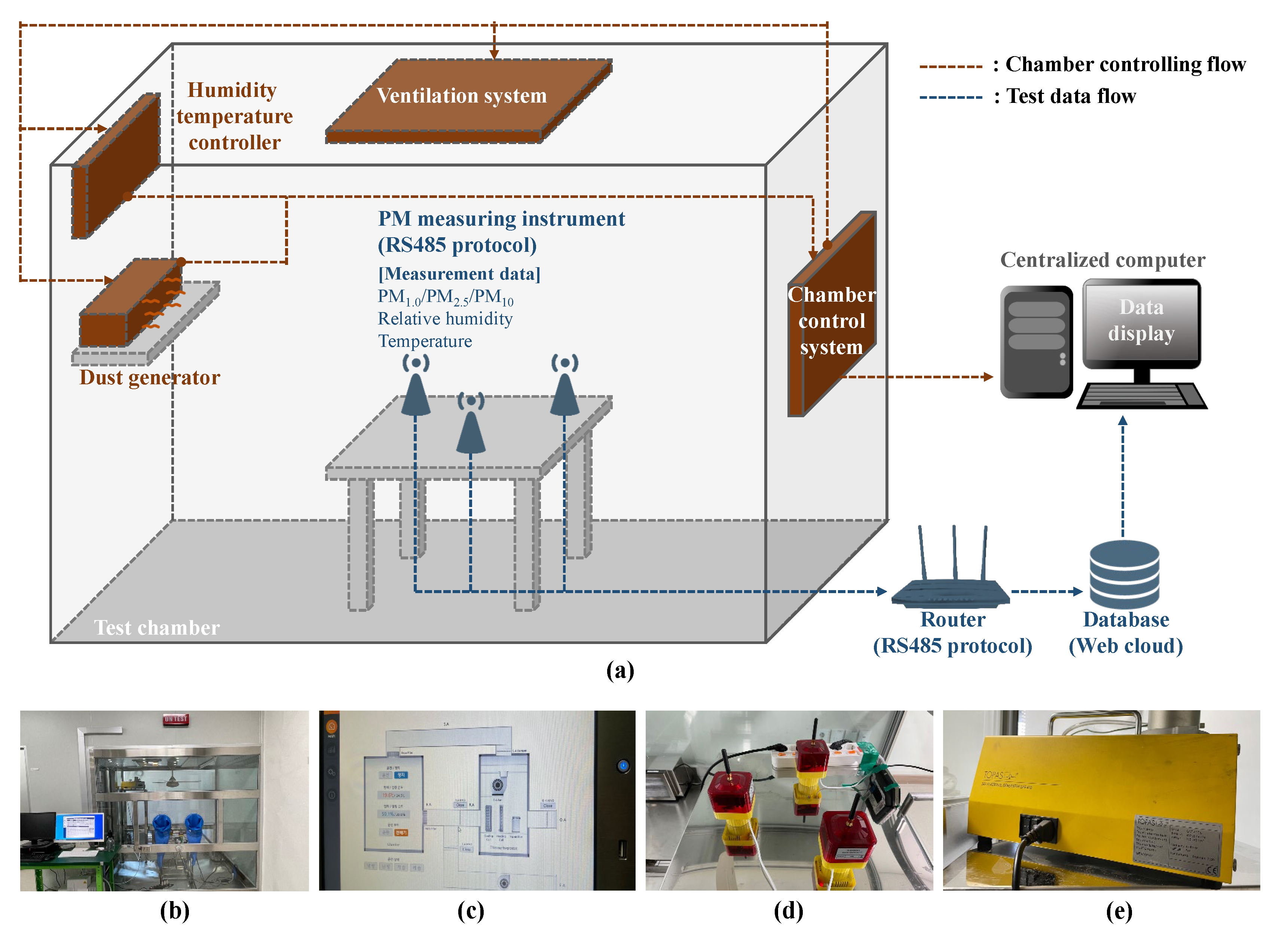
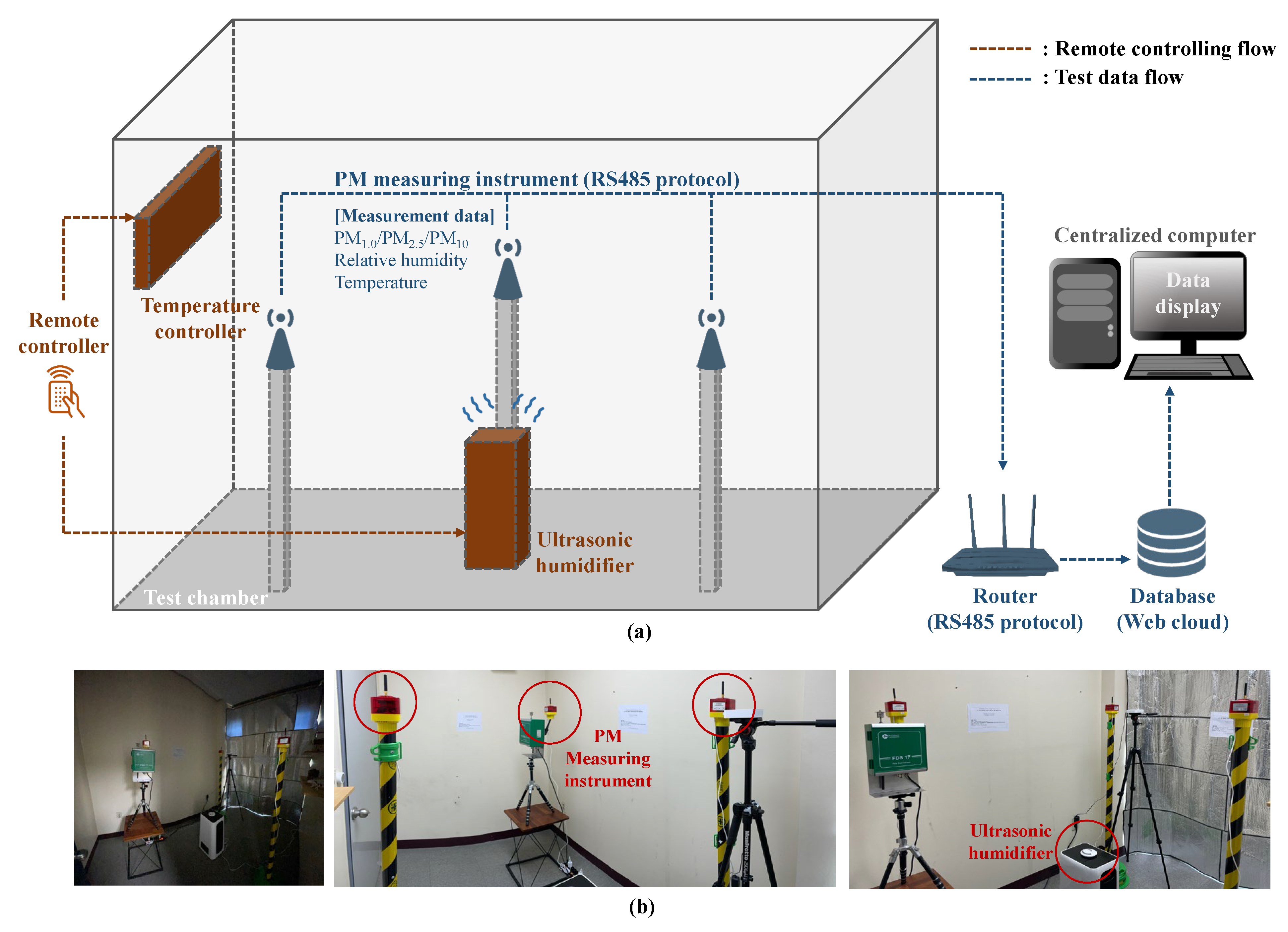
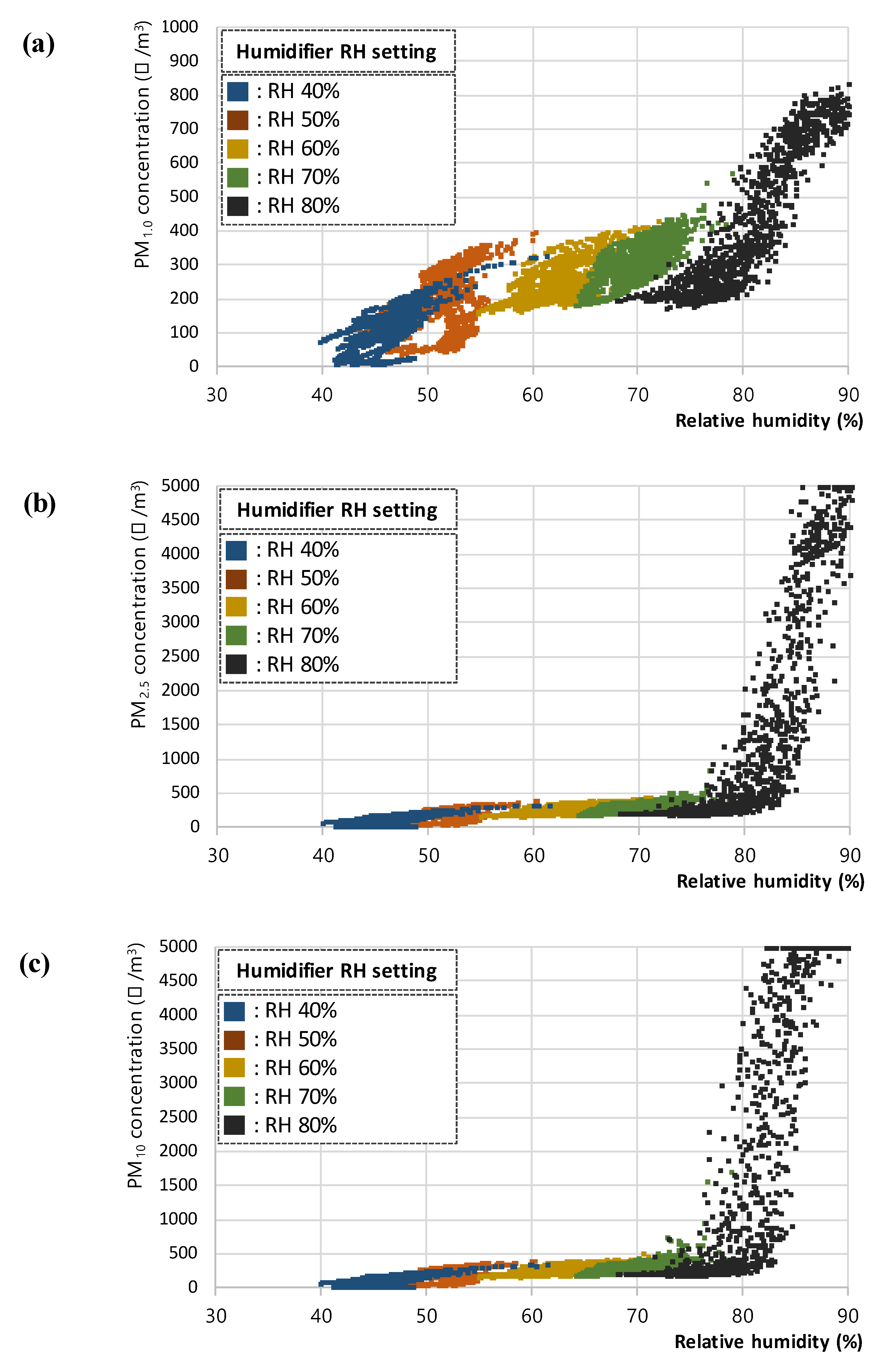



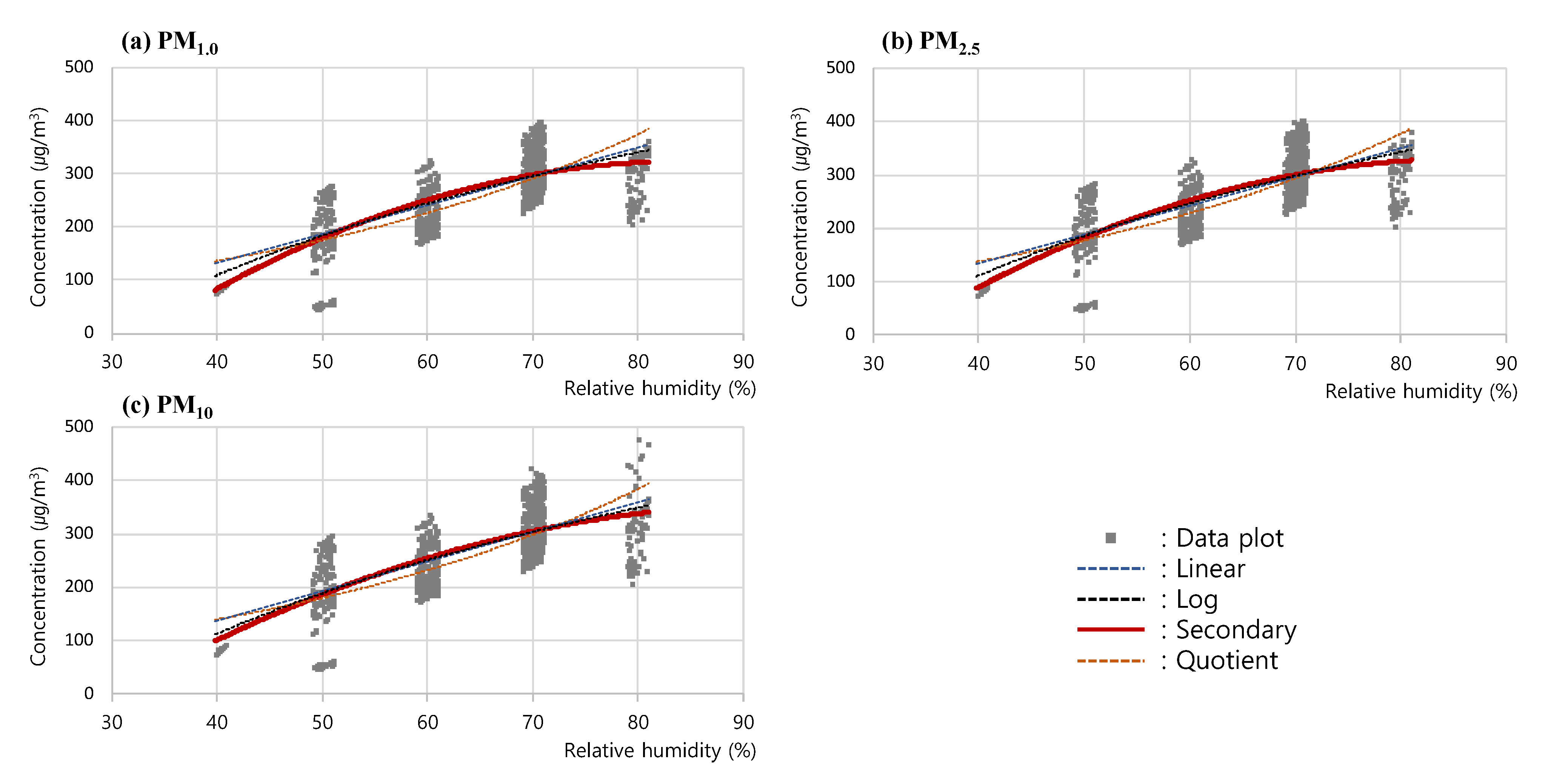
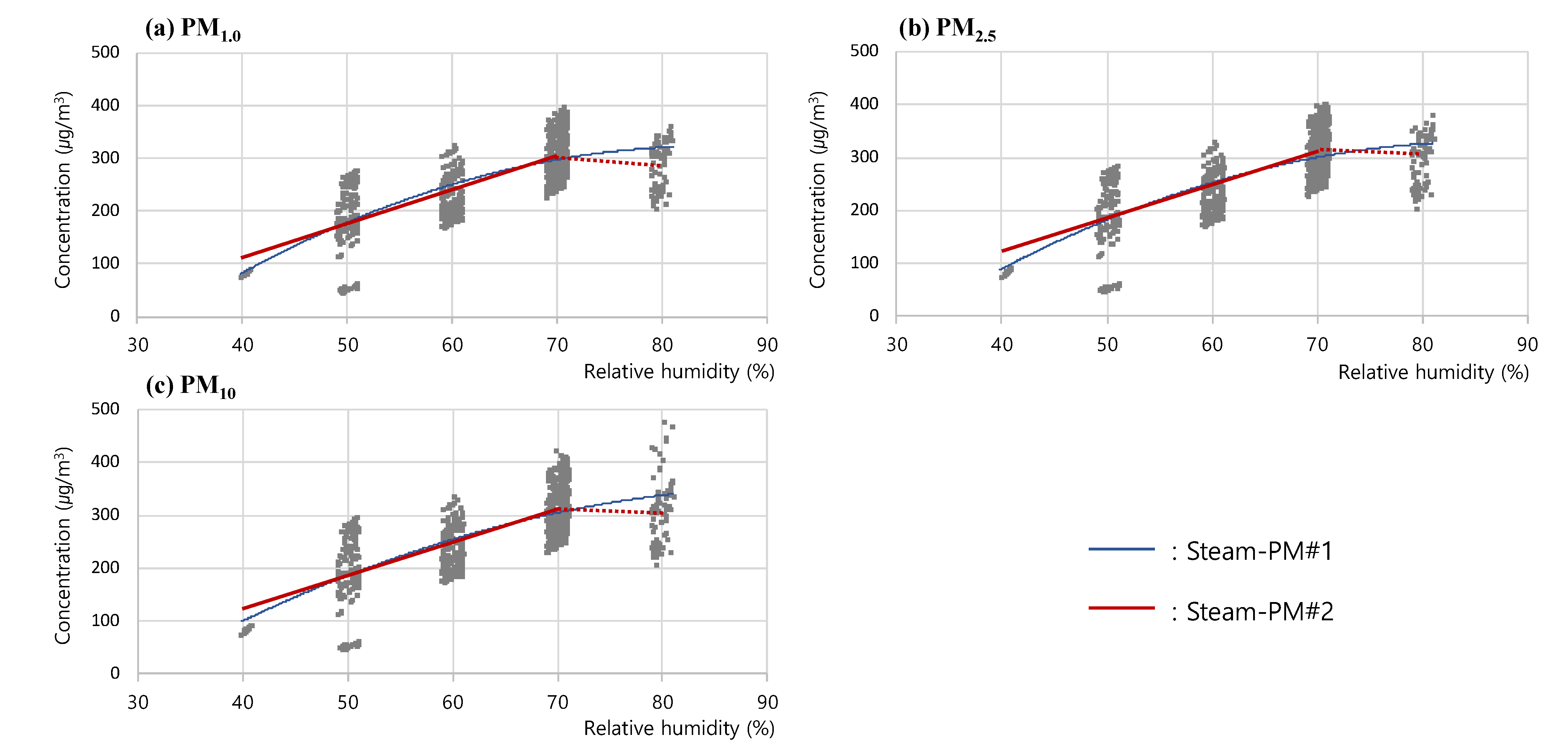
| RH (%) | MI | PM Concentration Data (μg/m3) | ||||||||||||||
|---|---|---|---|---|---|---|---|---|---|---|---|---|---|---|---|---|
| PM1.0 | PM2.5 | PM10 | ||||||||||||||
| 30 | MI 1. | 24 | 24 | 25 | 26 | 25 | 49 | 49 | 49 | 49 | 49 | 83 | 82 | 84 | 83 | 81 |
| MI 2. | 27 | 27 | 29 | 29 | 28 | 47 | 46 | 48 | 48 | 48 | 75 | 74 | 74 | 73 | 74 | |
| MI 3. | 21 | 20 | 21 | 20 | 20 | 55 | 51 | 56 | 55 | 56 | 113 | 96 | 110 | 112 | 116 | |
| Avg. | 24 | 24 | 25 | 25 | 24 | 50 | 49 | 51 | 51 | 51 | 90 | 84 | 89 | 89 | 90 | |
| 40 | MI 1. | 22 | 22 | 21 | 22 | 22 | 46 | 45 | 45 | 45 | 45 | 82 | 80 | 80 | 80 | 80 |
| MI 2. | 26 | 26 | 25 | 25 | 25 | 44 | 43 | 42 | 42 | 42 | 68 | 66 | 65 | 68 | 70 | |
| MI 3. | 18 | 17 | 18 | 18 | 18 | 52 | 50 | 53 | 51 | 53 | 108 | 101 | 105 | 101 | 109 | |
| Avg. | 22 | 22 | 21 | 22 | 22 | 47 | 46 | 47 | 46 | 47 | 86 | 82 | 83 | 83 | 86 | |
| 50 | MI 1. | 21 | 22 | 22 | 22 | 22 | 43 | 46 | 45 | 45 | 45 | 77 | 80 | 79 | 79 | 79 |
| MI 2. | 24 | 26 | 26 | 25 | 25 | 42 | 41 | 42 | 42 | 43 | 71 | 61 | 63 | 64 | 69 | |
| MI 3. | 17 | 17 | 18 | 19 | 17 | 46 | 47 | 49 | 54 | 50 | 94 | 96 | 98 | 110 | 102 | |
| Avg. | 21 | 22 | 22 | 22 | 21 | 44 | 45 | 45 | 47 | 46 | 81 | 79 | 80 | 84 | 83 | |
| 60 | MI 1. | 22 | 22 | 21 | 23 | 24 | 46 | 46 | 45 | 47 | 49 | 81 | 81 | 80 | 82 | 81 |
| MI 2. | 24 | 26 | 26 | 26 | 27 | 43 | 45 | 45 | 44 | 46 | 73 | 74 | 73 | 69 | 72 | |
| MI 3. | 18 | 18 | 18 | 18 | 17 | 50 | 49 | 50 | 54 | 53 | 97 | 99 | 100 | 107 | 111 | |
| Avg. | 21 | 22 | 22 | 22 | 23 | 46 | 47 | 47 | 48 | 49 | 84 | 85 | 84 | 86 | 88 | |
| 70 | MI 1. | 19 | 19 | 19 | 20 | 19 | 33 | 31 | 33 | 35 | 33 | 55 | 49 | 52 | 58 | 52 |
| MI 2. | 19 | 20 | 18 | 20 | 20 | 30 | 30 | 28 | 31 | 32 | 47 | 47 | 45 | 48 | 50 | |
| MI 3. | 14 | 14 | 14 | 14 | 15 | 31 | 31 | 31 | 30 | 33 | 57 | 57 | 56 | 52 | 55 | |
| Avg. | 17 | 18 | 17 | 18 | 18 | 31 | 31 | 31 | 32 | 33 | 53 | 51 | 51 | 53 | 52 | |
| PM | Standard Error of PM Concentration Data (μg/m3) | |||||
|---|---|---|---|---|---|---|
| RH 40 ± 1% | RH 50 ± 1% | RH 60 ± 1% | RH 70 ± 1% | RH 80 ± 1% | ||
| Before Data Extraction | After Data Extraction | |||||
| Number of data (PM1.0, PM2.5, PM10, respectively) | 12 | 186 | 239 | 534 | 152 | 73 |
| PM1.0 | 1.45 | 4.57 | 2.34 | 1.72 | 7.84 | 5.22 |
| PM2.5 | 1.49 | 4.71 | 2.36 | 1.76 | 33.91 | 5.44 |
| PM10 | 1.53 | 4.91 | 2.42 | 1.86 | 87.77 | 7.51 |
Disclaimer/Publisher’s Note: The statements, opinions and data contained in all publications are solely those of the individual author(s) and contributor(s) and not of MDPI and/or the editor(s). MDPI and/or the editor(s) disclaim responsibility for any injury to people or property resulting from any ideas, methods, instructions or products referred to in the content. |
© 2023 by the authors. Licensee MDPI, Basel, Switzerland. This article is an open access article distributed under the terms and conditions of the Creative Commons Attribution (CC BY) license (https://creativecommons.org/licenses/by/4.0/).
Share and Cite
Kim, H.; Kim, J.; Roh, S. Effects of Gas and Steam Humidity on Particulate Matter Measurements Obtained Using Light-Scattering Sensors. Sensors 2023, 23, 6199. https://doi.org/10.3390/s23136199
Kim H, Kim J, Roh S. Effects of Gas and Steam Humidity on Particulate Matter Measurements Obtained Using Light-Scattering Sensors. Sensors. 2023; 23(13):6199. https://doi.org/10.3390/s23136199
Chicago/Turabian StyleKim, Hyunsik, Jeonghwan Kim, and Seungjun Roh. 2023. "Effects of Gas and Steam Humidity on Particulate Matter Measurements Obtained Using Light-Scattering Sensors" Sensors 23, no. 13: 6199. https://doi.org/10.3390/s23136199
APA StyleKim, H., Kim, J., & Roh, S. (2023). Effects of Gas and Steam Humidity on Particulate Matter Measurements Obtained Using Light-Scattering Sensors. Sensors, 23(13), 6199. https://doi.org/10.3390/s23136199






